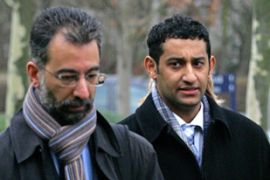London bomb plot trial opens
Chief prosecutor says plot was a long-planned operation, not a hasty copycat.

He said the accused on July 21, 2005, aimed to cause maximum injury by detonating homemade bombs packed with metal, which they carried in rucksacks onto the public transport system.
Their selection of targets – three underground trains and a bus – echoed those in the deadly attacks in London just two weeks earlier, on July 7, 2005.
The so-called failed second set of attacks caused panic and triggered a huge manhunt, leaving Londoners unclear at the time if they were a botched and quickly assembled attempt to imitate the original carnage.
But Sweeney told the high-security Woolwich Crown Court: “The evidence in this case shows that this conspiracy had been in existence long before the events of July 7.”
The six men, all originally from Africa and in their 20s, are charged with planning to set off explosives on three underground trains and a bus in London on July 21.
Sweeney said the 9th-floor flat of defendant Yassin Hassin Omar in north London was the bomb-making factory, that the detonator was triacetone triperoxide (TATP) and that the main charge was held in buckets surrounded by screws, tacks, washers and nuts.
“The purpose is, of course, to increase fragmentation when the bomb explodes and maximise the possibility of injury, fatal or otherwise, to those in the vicinity,” Sweeney told the court.
Chapati bomb
| “The evidence in this case shows that this conspiracy had been in existence long before the events of July 7”
Nigel Sweeney, |
Sweeney said that 5kg bombs were made from hydrogen peroxide, nail varnish and flour used to make chapatis, or unleavened bread. The bombs were then carried in rucksacks with wires connected to the detonators hidden under clothing.
He said four of the defendants successfully fired their TATP detonators, but the main charge failed to explode, possibly because the proportion of hydrogen peroxide was not right.
TATP is an explosive chemical which can be made from commonly available household products. Nicknamed “Mother of Satan”, it is highly volatile and liable to explode prematurely if subjected to friction, impact or change of temperature.
The suspected July 21 plot sparked one of Britain‘s biggest manhunts and all the main suspects on trial were apprehended just over a week after the “failed attacks”.
Muktah Said Ibrahim, Manfo Kwaku Asiedu, Hussein Osman, Yassin Hassin Omar, Ramzi Mohammed and Adel Yahya are all charged with conspiracy to murder.
The prosecutor said Osman had told police after being arrested in Italy that the bombings were a deliberate hoax to make a political point. Sweeney rejected the hoax defence.
Sweeney said Mohammed was seen trying to set off his bomb facing a woman with a pushchair and was wearing a top with New York on it, adding “no doubt connected with the events of 9/11”.
He said home-made films featuring images of beheadings and other attacks, including those on September 11, 2001, in New York, were found in the defendants’ flats.
They six are also accused of “conspiracy to cause explosions likely to endanger life or cause serious injury to property”.
Asiedu also faces the charge of “possessing an explosive substance with intent” in connection with a device police said had been abandoned in a park a few days later.